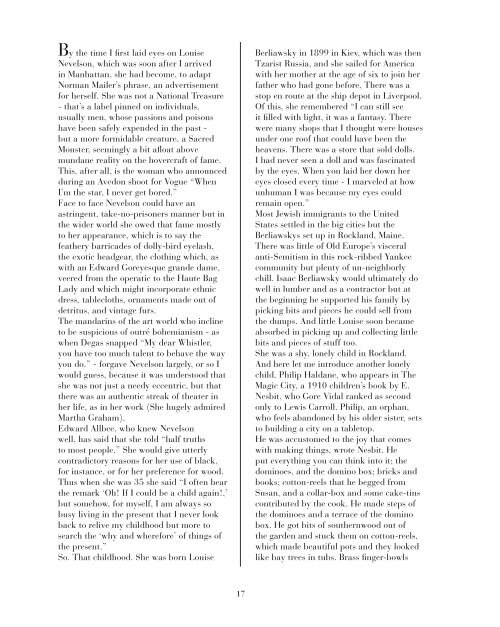Anthony Haden-Guest – Louise Nevelson
Excerpt from the book “Louise Nevelson – The Way I Think Is Collage”, the first monograph on one of the most important artists of the 20th century to focus on her collage works that spanned her entire career. Published by Galerie Gmurzynska on the occasion of an exhibition at the gallery space in Zurich.
Excerpt from the book “Louise Nevelson – The Way I Think Is Collage”, the first monograph on one of the most important artists of the 20th century to focus on her collage works that spanned her entire career. Published by Galerie Gmurzynska on the occasion of an exhibition at the gallery space in Zurich.
You also want an ePaper? Increase the reach of your titles
YUMPU automatically turns print PDFs into web optimized ePapers that Google loves.
By the time I first laid eyes on Louise<br />
<strong>Nevelson</strong>, which was soon after I arrived<br />
in Manhattan, she had become, to adapt<br />
Norman Mailer’s phrase, an advertisement<br />
for herself. She was not a National Treasure<br />
- that’s a label pinned on individuals,<br />
usually men, whose passions and poisons<br />
have been safely expended in the past -<br />
but a more formidable creature, a Sacred<br />
Monster, seemingly a bit afloat above<br />
mundane reality on the hovercraft of fame.<br />
This, after all, is the woman who announced<br />
during an Avedon shoot for Vogue “When<br />
I’m the star, I never get bored.”<br />
Face to face <strong>Nevelson</strong> could have an<br />
astringent, take-no-prisoners manner but in<br />
the wider world she owed that fame mostly<br />
to her appearance, which is to say the<br />
feathery barricades of dolly-bird eyelash,<br />
the exotic headgear, the clothing which, as<br />
with an Edward Goreyesque grande dame,<br />
veered from the operatic to the Haute Bag<br />
Lady and which might incorporate ethnic<br />
dress, tablecloths, ornaments made out of<br />
detritus, and vintage furs.<br />
The mandarins of the art world who incline<br />
to be suspicious of outré bohemianism - as<br />
when Degas snapped “My dear Whistler,<br />
you have too much talent to behave the way<br />
you do.” - forgave <strong>Nevelson</strong> largely, or so I<br />
would guess, because it was understood that<br />
she was not just a needy eccentric, but that<br />
there was an authentic streak of theater in<br />
her life, as in her work (She hugely admired<br />
Martha Graham).<br />
Edward Allbee, who knew <strong>Nevelson</strong><br />
well, has said that she told “half truths<br />
to most people.” She would give utterly<br />
contradictory reasons for her use of black,<br />
for instance, or for her preference for wood.<br />
Thus when she was 35 she said “I often hear<br />
the remark ‘Oh! If I could be a child again!,’<br />
but somehow, for myself, I am always so<br />
busy living in the present that I never look<br />
back to relive my childhood but more to<br />
search the ‘why and wherefore’ of things of<br />
the present.”<br />
So. That childhood. She was born Louise<br />
Berliawsky in 1899 in Kiev, which was then<br />
Tzarist Russia, and she sailed for America<br />
with her mother at the age of six to join her<br />
father who had gone before, There was a<br />
stop en route at the ship depot in Liverpool.<br />
Of this, she remembered “I can still see<br />
it filled with light, it was a fantasy. There<br />
were many shops that I thought were houses<br />
under one roof that could have been the<br />
heavens. There was a store that sold dolls.<br />
I had never seen a doll and was fascinated<br />
by the eyes. When you laid her down her<br />
eyes closed every time - I marveled at how<br />
unhuman I was because my eyes could<br />
remain open.”<br />
Most Jewish immigrants to the United<br />
States settled in the big cities but the<br />
Berliawskys set up in Rockland, Maine.<br />
There was little of Old Europe’s visceral<br />
anti-Semitism in this rock-ribbed Yankee<br />
community but plenty of un-neighborly<br />
chill. Isaac Berliawsky would ultimately do<br />
well in lumber and as a contractor but at<br />
the beginning he supported his family by<br />
picking bits and pieces he could sell from<br />
the dumps. And little Louise soon became<br />
absorbed in picking up and collecting little<br />
bits and pieces of stuff too.<br />
She was a shy, lonely child in Rockland.<br />
And here let me introduce another lonely<br />
child, Philip Haldane, who appears in The<br />
Magic City, a 1910 children’s book by E.<br />
Nesbit, who Gore Vidal ranked as second<br />
only to Lewis Carroll. Philip, an orphan,<br />
who feels abandoned by his older sister, sets<br />
to building a city on a tabletop.<br />
He was accustomed to the joy that comes<br />
with making things, wrote Nesbit. He<br />
put everything you can think into it; the<br />
dominoes, and the domino box; bricks and<br />
books; cotton-reels that he begged from<br />
Susan, and a collar-box and some cake-tins<br />
contributed by the cook. He made steps of<br />
the dominoes and a terrace of the domino<br />
box. He got bits of southernwood out of<br />
the garden and stuck them on cotton-reels,<br />
which made beautiful pots and they looked<br />
like bay trees in tubs. Brass finger-bowls<br />
17
















